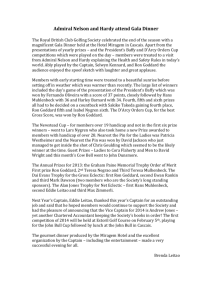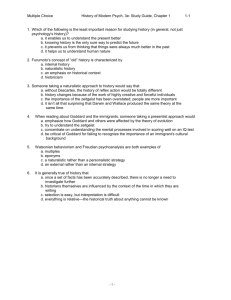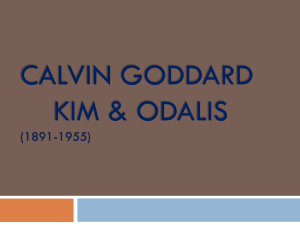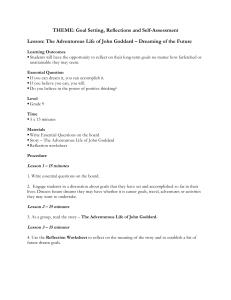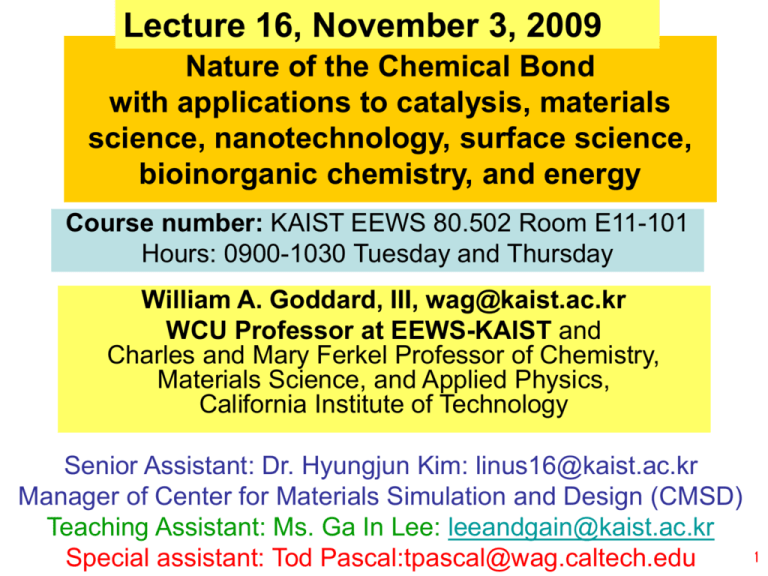
Lecture 16, November 3, 2009
Nature of the Chemical Bond
with applications to catalysis, materials
science, nanotechnology, surface science,
bioinorganic chemistry, and energy
Course number: KAIST EEWS 80.502 Room E11-101
Hours: 0900-1030 Tuesday and Thursday
William A. Goddard, III, wag@kaist.ac.kr
WCU Professor at EEWS-KAIST and
Charles and Mary Ferkel Professor of Chemistry,
Materials Science, and Applied Physics,
California Institute of Technology
Senior Assistant: Dr. Hyungjun Kim: linus16@kaist.ac.kr
Manager of Center for Materials Simulation and Design (CMSD)
Teaching Assistant: Ms. Ga In Lee: leeandgain@kaist.ac.kr
Special assistant:
Tod Pascal:tpascal@wag.caltech.edu
EEWS-90.502-Goddard-L15
© copyright
2009 William A. Goddard III, all rights reserved
1
Schedule changes
Nov. 3, Tuesday 9am, L16 as scheduled
Nov. 4, Wednesday, 1pm, L17, additional lecture, room 101
Nov. 5, Thursday, 9am, L18, as scheduled
Nov. 10,12 no lectures, wag lecturing in Stockholm, Sweden
Nov. 17, Tuesday, 9am, L19, as scheduled
Nov. 18, Wednesday, 1pm, L20, additional lecture room 101
Nov. 19, Thursday, 9am, L21, as scheduled
Nov. 24, Tuesday, 9am, L22, as scheduled
Nov. 25, Thursday, 9am, L23, as scheduled
EEWS-90.502-Goddard-L15
© copyright 2009 William A. Goddard III, all rights reserved
2
Last time
EEWS-90.502-Goddard-L15
© copyright 2009 William A. Goddard III, all rights reserved
3
Di-oxygen or O2 molecule
Next consider bonding of two O atoms. Each O has 3 possible
configurations (It is a 3P state) leading to 9 possible
configurations for O2. Of these one leads to directly to a double
bond
This suggests that the
ground state of O2 is a
singlet state.
At first this seemed plausible, but by the late 1920’s Mulliken
established experimentally that the ground state of O2 is
actually a triplet state, which he had predicted on the basis of
molecular orbitial (MO) theory.
This was a fatal blow to VB theory, bringing MO theory to the
fore, so we will consider next how Mulliken was able to figure
this
out in the 1920’s without
theWilliam
aid A.ofGoddard
computers.
EEWS-90.502-Goddard-L15
© copyright 2009
III, all rights reserved
4
The homonuclear diatomic correlation diagram
Mulliken knew the ordering of the atomic orbitals and
considered how combinations of the atomic orbitals
would change as the nuclei were pushed togtether to
eventually form a united atom.
First consider the separate atoms limit where there is a
large but finite distance R separating the atoms.
The next slide shows the combinations formed from 1s,
2s, and 2p orbitals.
EEWS-90.502-Goddard-L15
© copyright 2009 William A. Goddard III, all rights reserved
5
Separated
atoms limit
Note that in
each case we
get one bonding
combination (no
new nodal
plane) and one
antibonding
combination
(new nodal
plane,
red lines)
EEWS-90.502-Goddard-L15
© copyright 2009 William A. Goddard III, all rights reserved
6
Separated atom limit
MO notation
EEWS-90.502-Goddard-L15
Separated atoms notation
© copyright 2009 William A. Goddard III, all rights reserved
7
Summarizing united atom limit
Note for 3d, the splitting is
3ds < 3dp < 3dd
Same argument as for 2p
EEWS-90.502-Goddard-L15
© copyright 2009 William A. Goddard III, all rights reserved
8
Correlation diagram for Carbon row homonuclear diatomics
C2 N O
2
2
United
atom limit
EEWS-90.502-Goddard-L15
F2
O2+ separated
+
N
2
© copyright 2009 William A. Goddard III, all rights reserved atom limit9
Using the correlation diagram
In order to use the correlation
2
diagram to predict the states of
diatomic molecules, we need to
2
have some idea of what effective
4
R to use (actually it is the
effective overlap with large R
small S and small R large S).
Mulliken’s original analysis [Rev.
Mod. Phys. 4, 48 (1932)] was
roughly as follows.
1. N2 was known to be
nondegenerate and very strongly
bound with no low-lying excited
states
EEWS-90.502-Goddard-L15
2
4
4
2
2
2
2
2
© copyright 2009 William A. Goddard III, all rights reserved
10
N2 MO configurations
This is compatible with several
orderings of the MOs
Largest R
2
2
4
2
4
4
2
2
2
2
Smallest R
2
EEWS-90.502-Goddard-L15
© copyright 2009 William A. Goddard III, all rights reserved
11
N2+
But the 13 electron molecules BeF, BO, CO+, CN, N2+
Have a ground state with 2S symmetry and a low lying 2S
sate.
In between these two 2S states is a 2P state with spin
orbital splitting that implies a p3 configuration
This implies that
Is the ground configuration for N2 and that the low lying
states of N2+ are
This agrees with
the observed
spectra
EEWS-90.502-Goddard-L15
© copyright 2009 William A. Goddard III, all rights reserved
12
Correlation diagram for Carbon row homonuclear diatomics
C2 N O
2
2
United
atom limit
EEWS-90.502-Goddard-L15
F2
O2+ separated
+
N
13
2
© copyright 2009 William A. Goddard III, all rights reserved atom limit
B
A
B
EEWS-90.502-Goddard-L15
A
© copyright 2009 William A. Goddard III, all rights reserved
14
Bond
Anti
BO
1
2
2.5
3
2.5
2
1
EEWS-90.502-Goddard-L15
0
© copyright 2009 William A. Goddard III, all rights reserved
15
O2 MO configuration
2
For O2 the ordering of the MOs
4
Is unambiguous
2
(1pg)2
Next consider states of (1pg
)2
2
2
2
2
EEWS-90.502-Goddard-L15
© copyright 2009 William A. Goddard III, all rights reserved
16
States based on (p)2
Have 4 spatial combinations
Which we combine as
where x and y denote
px and py
φ1, φ2 denote the
angle about the axis
and F is independent of φ1, φ2
Rotating about the axis by an angle g, these states transform as
DSS+
D+
EEWS-90.502-Goddard-L15
© copyright 2009 William A. Goddard III, all rights reserved
17
new
EEWS-90.502-Goddard-L15
© copyright 2009 William A. Goddard III, all rights reserved
18
States arrising from (p)2
Adding spin we get
MO theory
explains the triplet
ground state and
low lying singlets
O2
Energy
(eV)
1.636
(p)2
EEWS-90.502-Goddard-L15
Ground state
© copyright 2009 William A. Goddard III, all rights reserved
0.982
0.0
19
First excited configuration
(1pg)2
Ground configuration
(1pu)3 (1pg)3 excited configuration
1S +
u
1D
(1pu)3 (1pg)3
u
3S u
Only dipole allowed
transition from 3Sg-
3S +
u
1S u
3D
u
Strong transitions (dipole allowed) DS=0 (spin)
- SS
S
or
P
but
S
g
u
u
EEWS-90.502-Goddard-L15
© copyright 2009 William A. Goddard III, all rights reserved
20
The states of O2 molecule
Moss and Goddard JCP 63, 3623 (1975)
(pu)3(pg)3
(pu)4(pg)2
EEWS-90.502-Goddard-L15
© copyright 2009 William A. Goddard III, all rights reserved
21
Exitation energies (eV) to O2 excited states
vertical
EEWS-90.502-Goddard-L15
© copyright 2009 William A. Goddard III, all rights reserved
22
Role of O2 in atmosphere
Moss and Goddard JCP 63, 3623 (1975)
Strong
Get 3P +
1D O atom
Weak
Get 3P +
3P O atom
EEWS-90.502-Goddard-L15
© copyright 2009 William A. Goddard III, all rights reserved
23
Implications
UV light > 6 eV (l < 1240/6 = 207 nm) can dissociate O2 by
excitation of 3Su+ which dissociates to two O atom in 3P state
UV light > ~7.2 eV can dissociate O2 by excitation of 3Suwhich dissociates to one O atom in 3P state and one in 1D
(maximum is at ~8.6 eV, Schumann-Runge bands)
Net result is dissociation of O2 into O atoms
EEWS-90.502-Goddard-L15
© copyright 2009 William A. Goddard III, all rights reserved
24
Regions of the
atmosphere
mesosphere
O + hn O+ + eHeats from light
stratopause
O + O2 O3
100
altitude (km)
O2 + hn O + O
O3 + hn O + O2
Heats from light
tropopause
50
stratosphere
30
20
10
troposphere
Heated from earth
200
EEWS-90.502-Goddard-L15
300
© copyright 2009 William A. Goddard III, all rights reserved
25
ionosphere
night
Heaviside-Kennelly layer
Reflects radio waves to allow
long distance communications
D layer day
EEWS-90.502-Goddard-L15
© copyright 2009 William A. Goddard III, all rights reserved
26
nightglow
At night the O atoms created
during the day can recombine to
form O2
The fastest rates are into the
Herzberg states, 3Su+ 1Su-
3D
u
Get emission at ~2.4 eV, 500 nm
Called the nightglow (~ 90 km)
EEWS-90.502-Goddard-L15
© copyright 2009 William A. Goddard III, all rights reserved
27
Problem with MO description: dissociation
3S g
state: [(pgx)(pgy)+ (pgy) (pgx)]
As R∞ (pgx) (xL – xR) and (pgy) (yL – yR)
Get equal amounts of {xL yL and xR yR} and {xLyR and xR yL}
Ionic: [(O-)(O+)+ (O+)(O-)]
covalent: (O)(O)
But actually it should dissociate to neutral atoms
EEWS-90.502-Goddard-L15
© copyright 2009 William A. Goddard III, all rights reserved
28
Back to valence bond (and GVB)
Four ways to combine two 3P states of O to form a s bond
bad
Closed shell
Open shell
Each doubly occupied orbital
overlaps a singly occupied
orbital, not so repulsive
EEWS-90.502-Goddard-L15
Looks good because make p
bond as in ethene, BUT have
overlapping doubly occupied
orbitals antibonding
© copyright 2009 William A. Goddard III, all rights reserved
29
Analysis of open shell configurations
Each can be used to form a singlet state or a triplet state, e.g.
Singlet: A{(xL)2(yR)2[(yL)(xR) + (xR)(yL)](ab-ba)}
Triplet: A{(xL)2(yR)2[(yL)(xR) - (xR)(yL)](ab+ba)} and aa, bb
Since (yL) and (xR) are orthogonal, high spin is best (no
chance of two electrons at same point) as usual
EEWS-90.502-Goddard-L15
© copyright 2009 William A. Goddard III, all rights reserved
30
GVB wavefunction of triplet O2: sigma orbitals
(O2sL)2
O2pzL
bond
O2pzR
(O2sR)2
R=4 bohr
R=3 bohr
Re=2.28 bohr
Get orthogonal to O2s on other center
Causes some (2s-lpz) to stay orthogonal to bond pair
Moss,
EEWS-90.502-Goddard-L15
Bobrowicz,
Goddard
63, 4632
© copyright 2009
WilliamJCP
A. Goddard
III, all (1975)
rights reserved
31
GVB wavefunction of triplet O2: pi orbitals
(OpxL
)2
O2pxR
Spin
paired
O2pyL
(OpyR)2
R=4 bohr
R=3 bohr
Re=2.28 bohr
Get orthogonal to O2pp on other center
Doubly occupied orbtial delocalizes (bonding)
Moss,
EEWS-90.502-Goddard-L15
Bobrowicz,
Goddard
63, 4632
© copyright 2009
WilliamJCP
A. Goddard
III, all (1975)
rights reserved
32
GVB orbitals at Re
Problem: one VB configuration
not enough
+
EEWS-90.502-Goddard-L15
© copyright 2009 William A. Goddard III, all rights reserved
33
VB description of O2
+
+
+
Must have resonance of two
VB configurations
EEWS-90.502-Goddard-L15
© copyright 2009 William A. Goddard III, all rights reserved
34
Bond energies
5.2 eV
EEWS-90.502-Goddard-L15
© copyright 2009 William A. Goddard III, all rights reserved
35
Bond H to O2
Bring H toward px on Left O
Overlap doubly
occupied (pxL)2
thus repulsive
Overlap singly
occupied (pxL)2
thus bonding
Get HOO bond angle ~ 90º
S=1/2 (doublet)
Antisymmetric with respect to plane:
A” irreducible representation (Cs
group)
2A”
state
EEWS-90.502-Goddard-L15
Bond weakened by ~ 57 kcal/mol
due
to A.loss
in III,O2
resonance
© copyright 2009
William
Goddard
all rights
reserved
36
Bond 2nd H to HO2 to form hydrogen peroxide
Bring H toward py on right O
Expect new HOO bond angle ~ 90º
Expect HOOH dihedral ~90º
Indeed H-S-S-H, H-Se-Se-H
Have these values
But H-H overlap leads to steric effects, for
HOOH, net result: HOOH angle 111º and
trans structure, 180º only ~ 1 kcal/mol higher
Also HOO opens up to ~95º
EEWS-90.502-Goddard-L15
© copyright 2009 William A. Goddard III, all rights reserved
37
Compare bond energies (kcal/mol)
O2 3Sg-
119.0
50.8
HO-O
68.2
67.9
H-O2
51.5
17.1
HO-OH
51.1
HOO-H
85.2
Interpretation:
OO s bond ~ 51 kcal/mol
OO p bond ~ 68 kcal/mol (resonance)
Bonding H to O2 loses 51 kcal/mol of resonance
Bonding H to HO2 loses the other 17 kcal/mol of resonance
Intrinsic H-O bond is 85.2 + 17.1 =102.3
compare CH3O-H 105.1
EEWS-90.502-Goddard-L15
© copyright 2009 William A. Goddard III, all rights reserved
38
Bond O2 to O to form
ozone
Require two OO s bonds get
States with 4, 5, and 6 pp
electrons
Ground state is 4p case
Get S=0,1
but 0 better
Goddard
et al Acc. Chem. Res.
6, 368 (1973)
EEWS-90.502-Goddard-L15
© copyright 2009 William A. Goddard III, all rights reserved
39
sigma GVB orbitals ozone
EEWS-90.502-Goddard-L15
© copyright 2009 William A. Goddard III, all rights reserved
40
Pi GVB orbitals ozone
Some delocalization of central Opp pair
EEWS-90.502-Goddard-L15
Increased overlap
between L and R Opp
due to central pair
© copyright 2009 William A. Goddard III, all rights reserved
41
Bond O2 to O to form ozone
lose O-O p resonance, 51 kcal/mol
New O-O s bond, 51 kcal/mol
Gain O-Op resonance,<17 kcal/mol,assume 2/3
New singlet coupling of pL and pR orbitals
Total splitting ~ 1 eV = 23 kcal/mol, assume ½
stabilizes singlet and ½ destabilizes triplet
Expect bond for singlet of 11 + 12 = 23 kcal/mol, exper = 25
Expect triplet state to be bound by 11-12 = -1 kcal/mol,
probably between +2
and -2
EEWS-90.502-Goddard-L15
© copyright
2009 William A. Goddard III, all rights reserved
42
Photochemical smog
High temperature combustion: N2 + O2 2NO
2NO + O2 2NO2
Auto exhaust NO
NO2 + hn NO + O
O + O2 + M O3 + M
O3 + NO NO2 + O2
Get equilibrium
Add in hydrocarbons
NO2 + O2 + HC + hn MeC=O)-OO-NO2
peroxyacetylnitrate
EEWS-90.502-Goddard-L15
© copyright 2009 William A. Goddard III, all rights reserved
43
Compare bond energies
EEWS-90.502-Goddard-L15
© copyright 2009 William A. Goddard III, all rights reserved
44
Compare bond distances
EEWS-90.502-Goddard-L15
© copyright 2009 William A. Goddard III, all rights reserved
45
EEWS-90.502-Goddard-L15
© copyright 2009 William A. Goddard III, all rights reserved
46
EEWS-90.502-Goddard-L15
© copyright 2009 William A. Goddard III, all rights reserved
47


